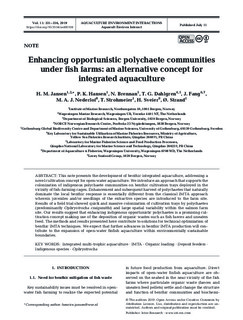| dc.contributor.author | Jansen, Henrice M | |
| dc.contributor.author | Hansen, Pia Kupka | |
| dc.contributor.author | Brennan, N. | |
| dc.contributor.author | Dahlgren, Thomas Gunnar | |
| dc.contributor.author | Fang, J. | |
| dc.contributor.author | Nederlof, M.A.J | |
| dc.contributor.author | Strohmeier, Tore | |
| dc.contributor.author | Sveier, H. | |
| dc.contributor.author | Strand, Øivind | |
| dc.date.accessioned | 2020-01-24T11:33:59Z | |
| dc.date.available | 2020-01-24T11:33:59Z | |
| dc.date.created | 2019-09-18T13:33:10Z | |
| dc.date.issued | 2019 | |
| dc.identifier.citation | Aquaculture Environment Interactions. 2019, 11 331-336. | nb_NO |
| dc.identifier.issn | 1869-215X | |
| dc.identifier.uri | http://hdl.handle.net/11250/2637816 | |
| dc.description.abstract | This note presents the development of benthic integrated aquaculture, addressing a novel cultivation concept for open-water aquaculture. We introduce an approach that supports the colonization of indigenous polychaete communities on benthic cultivation trays deployed in the vicinity of fish-farming cages. Enhancement and subsequent harvest of polychaetes that naturally dominate the local benthic response is essentially different from the classical IMTA approach wherein juveniles and/or seedlings of the extractive species are introduced to the farm site. Results of a field trial showed quick and massive colonization of cultivation trays by polychaetes (predominantly Ophryotrocha craigsmithi) and large spatial variability within the salmon farm site. Our results suggest that enhancing indigenous opportunistic polychaetes is a promising cultivation concept making use of the deposition of organic wastes such as fish faeces and uneaten feed. The methods and results presented here contribute to solutions for technical optimization of benthic IMTA techniques. We expect that further advances in benthic IMTA production will contribute to the expansion of open-water finfish aquaculture within environmentally sustainable boundaries. | nb_NO |
| dc.language.iso | eng | nb_NO |
| dc.title | Enhancing opportunistic polychaete communities under fish farms: an alternative concept for integrated aquaculture | nb_NO |
| dc.type | Journal article | nb_NO |
| dc.type | Peer reviewed | nb_NO |
| dc.description.version | publishedVersion | nb_NO |
| dc.source.pagenumber | 331-336 | nb_NO |
| dc.source.volume | 11 | nb_NO |
| dc.source.journal | Aquaculture Environment Interactions | nb_NO |
| dc.identifier.doi | 10.3354/aei00318 | |
| dc.identifier.cristin | 1726234 | |
| cristin.unitcode | 7431,0,0,0 | |
| cristin.unitcode | 7431,12,0,0 | |
| cristin.unitname | Havforskningsinstituttet | |
| cristin.unitname | Bentiske ressurser og prosesser | |
| cristin.ispublished | true | |
| cristin.fulltext | original | |
| cristin.qualitycode | 1 | |
